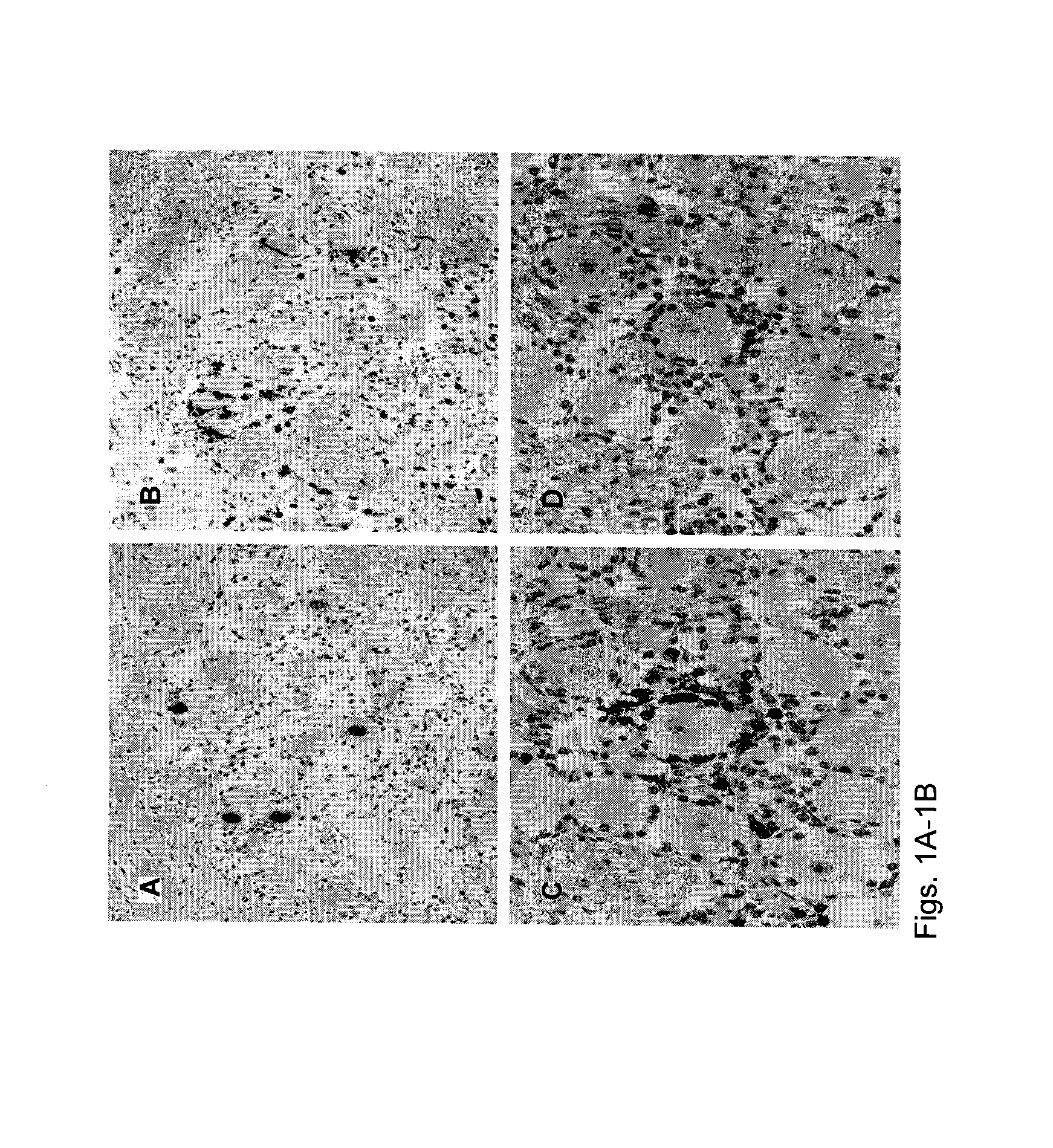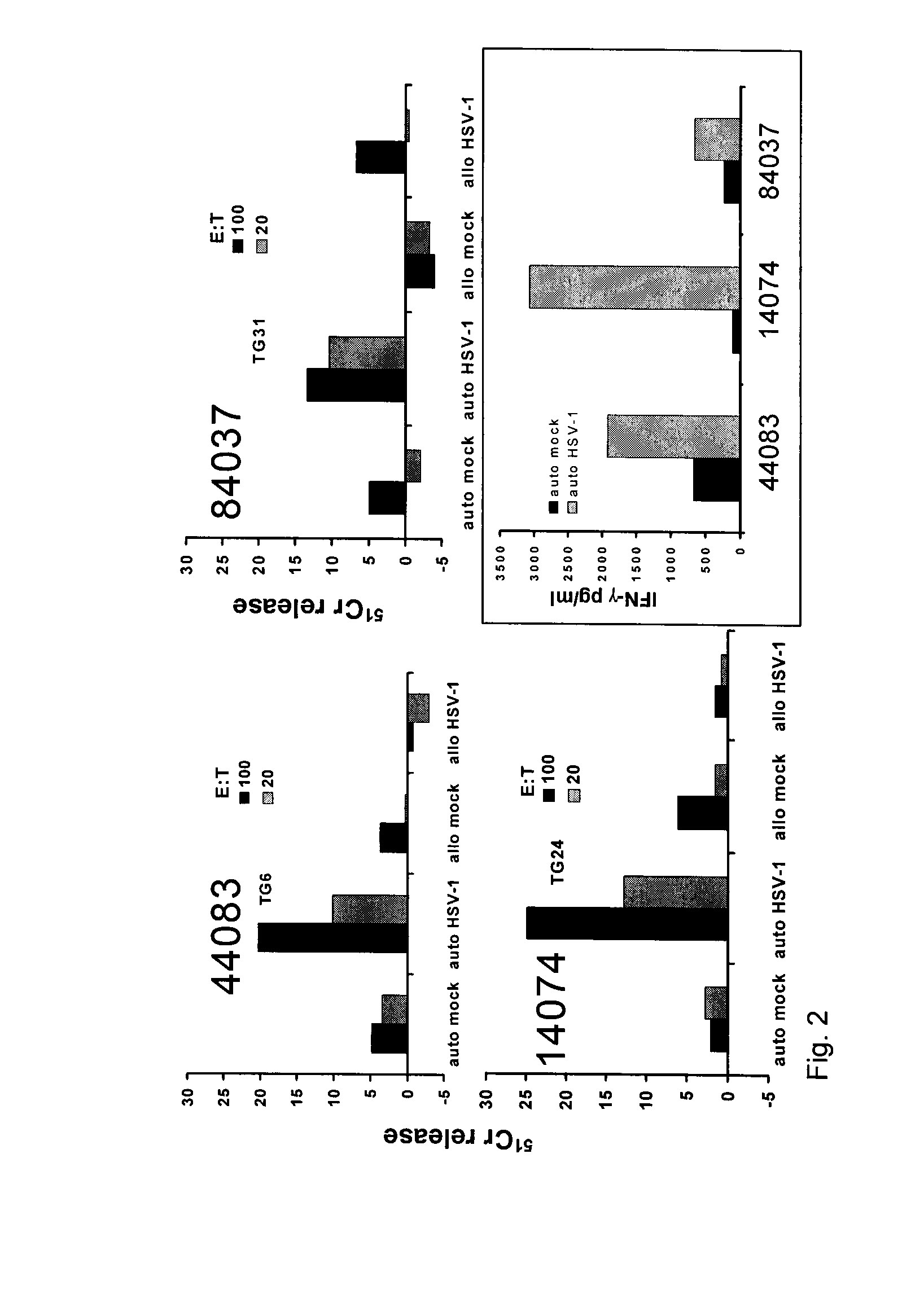Hsv-1 epitopes and methods for using same
- Summary
- Abstract
- Description
- Claims
- Application Information
AI Technical Summary
Benefits of technology
Problems solved by technology
Method used
Image
Examples
example 1
Discovery of HSV-1 T-Cell Antigens and Epitopes Recognized by Human TG-Infiltrating CD8 T-Cells
[0094]Selective retention of HSV-1-specific T-cells in human TG. TG and blood were harvested a median of 5.5 hours post-mortem (range, 4-10 hours). Serology was done to diagnose HSV-1 infection. A portion of each TG was used for DNA and RNA isolation. Most specimens from HSV-1-infected persons had HSV-1 DNA (median 3,321±879 copies / 105 TG cells by PCR). TG of HSV-1-seronegative donors were PCR-negative for HSV-1. Within HSV-1 DNA (+) specimens, we detected LAT by RT-PCR (1). Immunohistology showed that HSV-1 seropositive donors had 2.1±0.4 CD3+ T-cells per neuron compared to 0.3±0.1 for HSV-1 uninfected donors (58). T-cell clusters were juxtaposed to HSV-1 LAT+ neurons (FIG. 1A-B). These clusters contained mainly CD8 T-cells expressing CD69, granzyme B and TIA-1 (119), consistent with activated cytotoxic T-cells (FIG. 1C-D) (2).
[0095]Cell suspensions were made from portions of TG using Lib...
example 2
HSV-1 T-Cell Antigens and Epitopes Recognized by CD4 T-Cells of TG
[0140]Further studies have identified two regions in the HSV-1 UL48 protein that are recognized by CD4 T-cells in the human trigeminal ganglia. The large fragments of amino acids 141-240 and amino acids 218-320 were reactive in the CD4 cell tests. To follow up, we showed that amino acids 187-199 (VRQLHRQAHMRGR) and the overlapping region amino acids 191-203 (HRQAHMRGRDRDL) were both reactive. It is likely that there is a small region of the UL48 protein that is contained in the overlap region that is the minimum reactive region, e,g. at or near amino acids 191-199. We also showed that amino acids 215-227 (YYRETARLARVLF) and the overlapping amino acids 219-230 (TARLARVLFLHL) were reactive with CD4 T cells. Again, it is likely that there is a minimal reactive region in the overlap of these two, e,g. at or near amino acids 219-227.
example 3
HSV-1 T-Cell Antigens and Epitopes Relevant to a Significant Population
[0141]The regions of HSV-1 UL1, UL48, and UL53 that stimulate CD8 T-cells were found in a subject who has the A*0101 variant of the human gene HLA-A. From 10% to 20% of many ethnic and national populations have the HLA type A*0101. The precise genetic variant possessed by different persons controls which portions of which viral proteins their T-cells can recognize. However, it is not always true that regions of viruses are recognized by all persons who have the correct HLA genetic variant. Antigenic regions that are recognized by most or all persons with the relevant HLA genetic variant are more likely to be of interest for use in a vaccine. To test this, we studied 3 random healthy persons who have HSV-1 infection and HLA A*0101. For each person, all three of the peptides UL1 66-74, UL53 201-209, and UL48 90-99 were strongly recognized by 3 out of 3 people. This supports their utility in vaccines.
PUM
| Property | Measurement | Unit |
|---|---|---|
| Fraction | aaaaa | aaaaa |
| Fraction | aaaaa | aaaaa |
| Fraction | aaaaa | aaaaa |
Abstract
Description
Claims
Application Information
 Login to View More
Login to View More - R&D
- Intellectual Property
- Life Sciences
- Materials
- Tech Scout
- Unparalleled Data Quality
- Higher Quality Content
- 60% Fewer Hallucinations
Browse by: Latest US Patents, China's latest patents, Technical Efficacy Thesaurus, Application Domain, Technology Topic, Popular Technical Reports.
© 2025 PatSnap. All rights reserved.Legal|Privacy policy|Modern Slavery Act Transparency Statement|Sitemap|About US| Contact US: help@patsnap.com



